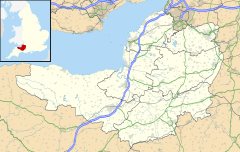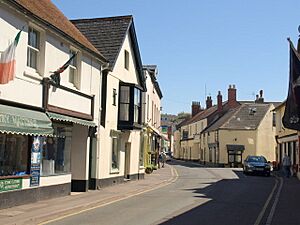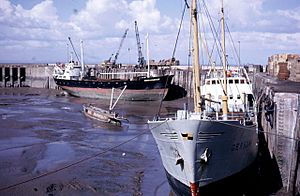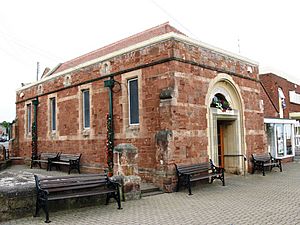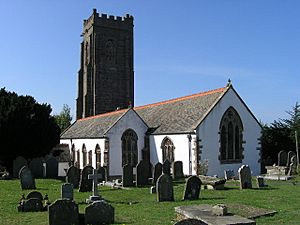Watchet facts for kids
Quick facts for kids Watchet |
|
|---|---|
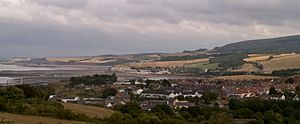 View overlooking Watchet |
|
| Population | 3,785 |
| OS grid reference | ST074431 |
| Civil parish |
|
| Unitary authority |
|
| Shire county | |
| Region | |
| Country | England |
| Sovereign state | United Kingdom |
| Post town | WATCHET |
| Postcode district | TA23 |
| Dialling code | 01984 |
| Police | Avon and Somerset |
| Fire | Devon and Somerset |
| Ambulance | South Western |
| EU Parliament | South West England |
| UK Parliament |
|
Watchet is a small harbour town in Somerset, England. In 2011, about 3,785 people lived there. It's located on the coast, where the Washford River meets Bridgwater Bay, which is part of the Bristol Channel. The town is also very close to the beautiful Exmoor National Park.
Watchet has a long and interesting history. It started as an Iron Age fort and then grew into a busy port. Vikings even attacked it in the 900s! Over time, the harbour became important for trading goods like paper and iron ore. Today, the old commercial port has been turned into a marina for pleasure boats.
The town's church is named after Saint Decuman, who is believed to have died there around 706 AD. Watchet is also famous for its connection to the poet Samuel Taylor Coleridge. His well-known poem, The Rime of the Ancient Mariner, was inspired by the area. You can even see a statue of the Ancient Mariner by the harbour!
In 2021, a new art gallery and arts centre called East Quay Watchet opened, adding to the town's cultural scene.
Contents
What's in a Name? The Meaning of Watchet
The name Watchet has been around for a long time, appearing in old documents from the 900s. It comes from ancient British words that mean "under the wood." So, the town's name tells us it was once located below a wooded area.
Watchet's Long History
Ancient Times and Early Settlers
Just west of Watchet, you'll find Daw's Castle. This was an Iron Age hill fort, built high on a cliff. Later, around 878 AD, Alfred the Great strengthened it to protect against Vikings who raided from the Bristol Channel. A Saxon mint, where coins were made, was set up here in 1035. These coins have been found in places as far away as Copenhagen and Stockholm!
The Anglo-Saxons took control of Watchet around 680 AD. The town became an important port under Alfred the Great. However, the Anglo-Saxon Chronicle tells us that Danish raiders attacked and robbed the port in 987 and 997.
Watchet's Busy Paper Mill
Watchet has a history of making paper, going all the way back to 1652. A flour mill near the Washford River started making paper by 1652. In the 1800s, it became a big factory called Wansbrough Paper Mill. It used water power and later steam power. The mill used the local harbour to bring in materials and send out its paper products.
Most of the mill was destroyed by a fire in 1889, but it was quickly rebuilt. It grew to be the largest maker of paper bags in the UK! Later, it became the biggest producer of coreboard in the UK, making paper for things like cardboard tubes. Sadly, the paper mill closed down in December 2015.
Watchet's Harbour: A Hub of Trade
Watchet grew as a town because it was close to minerals in the Brendon Hills and had good access to the River Severn for shipping. From 1564, the port was used to import salt and wine from France.
During the English Civil War in 1643, an interesting event happened. A Royalist ship was sent to Watchet to help with a siege. But Parliamentarian soldiers, led by Captain Popham, attacked the ship while it was stuck in the low tide. They fired their guns from horseback, and the Royalist commander had to surrender. This was unusual because the ship was technically at sea but captured by soldiers on land!
The harbour's old wooden pier was damaged in a storm in 1659. So, in 1708, a local merchant named Sir William Wyndham built a new, stronger pier. In the 1800s, trade really picked up, especially with the export of iron ore from the Brendon Hills. This ore was sent mainly to Newport in Wales for steelmaking. Paper, flour, and gypsum were also traded.
In 1859, a big storm called the Royal Charter storm damaged the harbour again and wrecked several ships. A new east pier and wharf were finished in 1862. This helped the harbour become very busy, with over 1,100 ship movements each year. The arrival of the railway also helped trade. The West Somerset Mineral Railway brought iron ore from the Brendon Hills, and the West Somerset Railway connected Watchet to other towns. At its busiest, 40,000 tons of iron ore were shipped out every year.
The Lighthouse and Shipwrecks
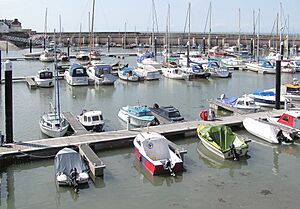
In 1862, the cast-iron Watchet Harbour Lighthouse was built. In 2012, Princess Anne visited to celebrate its 150th anniversary. The iron mines and the West Somerset Mineral Railway closed in 1898. The West Somerset Railway, which went to Minehead, continued until 1971. Today, it's a popular heritage railway.
After the First World War, a company scrapped a large warship called HMS Fox in Watchet harbour. It was 320 feet long, the biggest ship ever to enter the harbour! Before the Second World War, a gunnery range was set up near Watchet for the army to practice anti-aircraft shooting.
The port kept importing wood pulp and esparto grass for the paper mills until 2000. Now, the harbour is a marina for pleasure boats. The old quaysides and narrow streets have been updated, making it a nice place to visit.
Museums in Watchet
Watchet has several museums where you can learn about its past:
- The Market House Museum tells the story of the town and its harbour. It's in a building built in 1820 and became a museum in 1979. It has items about Watchet's nature, sea history, and social life. Behind the museum, you can see the old town lock-up, where people (often drunks) were held temporarily.
- The Watchet Boat Museum is in an old railway goods shed from 1862. It shows off the unique local "flatner" boats and other related items.
The Lifeboat Station
The Royal National Lifeboat Institution (RNLI) had a lifeboat station in Watchet from 1875. The station closed in 1944 because a new motor lifeboat at nearby Minehead could cover the area. The lifeboat was launched from a slipway, but its boathouse was near the railway station. Today, the old boathouse has been turned into a library.
How Watchet is Governed
Watchet has a town council that helps manage local matters. It's also part of Somerset Council, which is a larger local government body.
Watchet is part of the Tiverton and Minehead area for the UK Parliament. This means people in Watchet vote for one Member of Parliament (MP) to represent them in the House of Commons. In 2024, Rachel Gilmour was elected as the MP for this area.
Watchet's Landscape and Nature
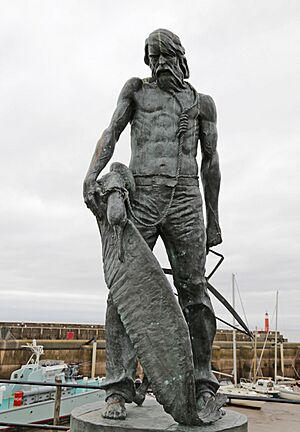
The coast at Watchet is rocky, and the tide goes in and out a lot, with a big difference of about 6 meters. The cliffs between Watchet and Blue Anchor have a special pale, greenish-blue colour. This comes from the coloured alabaster found there. In the 1500s, the colour "Watchet Blue" was even named after this!
Kentsford Bridge is an old packhorse bridge over the Washford River. It was likely used before the Reformation and was repaired in 1613.
Watchet's Culture and Traditions
The Rime of the Ancient Mariner
Samuel Taylor Coleridge wrote his famous poem The Rime of the Ancient Mariner in 1797 while he was traveling near Watchet. It's said that seeing the harbour from St. Decuman's Church gave him the idea for the poem. In 2003, a statue of the Ancient Mariner was put up at the harbour to remember this connection.
Fun Local Traditions
Watchet has some unique traditions:
- Lantern Night is held on September 16th. Children in the town make lanterns from hollowed-out root vegetables like mangelwurzel or swede and carry them. This tradition is a reminder of the old Watchet Fair.
- Queen Caturn's Day is on the last Saturday of November. Watchet was known for its blue dye, and Queen Caturn was so impressed that she gave the town's people cider and cakes as a reward. This tradition is still celebrated with costumes and fun today!
Local News and Entertainment
For local news and TV, Watchet gets BBC West and ITV West Country. You can also listen to local radio stations like BBC Radio Somerset, Heart West, Greatest Hits Radio South West, and West Somerset Radio, which broadcasts from the town. Local newspapers include the West Somerset Free Press and the Somerset County Gazette.
Getting Around: Watchet's Railways
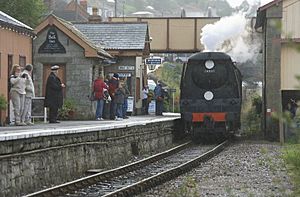
Next to the harbour is Watchet station. This is now a stop on the West Somerset Railway, which is a fun heritage railway that mostly uses steam trains. It connects Bishops Lydeard (near Taunton) with Minehead. The station first opened in 1862 to help transport goods from Watchet's port. The line was later extended to Minehead in 1874. Passenger trains stopped running in 1971, but the station was reopened by the new West Somerset Railway in 1976.
The harbour was also connected to another railway, the West Somerset Mineral Railway. This line went to iron ore mines in the Brendon Hills. From Watchet, the ore was shipped across the Bristol Channel to Newport to be turned into iron. This railway closed in 1898 because the mines weren't producing as much ore.
Today, you can walk along the path where the old West Somerset Mineral Railway used to be, from the harbour in Watchet to Washford station.
Schools in Watchet
The Knights Templar Church of England/Methodist Community School is in Watchet. It was built in 1990 on land that used to belong to the Knights Templar. Older students can go to middle and upper schools in nearby Williton and Minehead, including The West Somerset Community College.
Places of Worship
The Anglican St Decuman's church is on a hilltop between Watchet and Williton. It might be on a very old, pre-Christian site. An earlier church was by the sea, but it had to be left because the sea was eroding the land. When the church was rebuilt in the 1100s, it seems the bones of St Decuman were moved there.
The current church, which is a Grade I listed building, was mostly built in the 1400s and 1500s. It has beautiful old windows and carved wooden roofs. Inside, there's a special chapel for the Wyndham family, who used to own the land. You can see memorials to important family members, including Sir John Wyndham, who helped organize defenses against the Spanish Armada.
Below the church is St Decuman's well, which was rebuilt in the 1800s. Besides St Decuman's Church, Watchet also has a Methodist church (built in 1871) and a Baptist church (built in 1824). About 2 miles west of Watchet, in the village of Washford, you can find Cleeve Abbey, one of England's best-preserved medieval monasteries.
See also
 In Spanish: Watchet para niños
In Spanish: Watchet para niños


